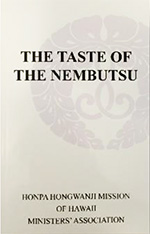
A message from Rev. Mieko Majima which appears in the book, “The Taste of the Nembutsu,” published in 2016 by the HHMH State Ministers’ Association. The book is a collection of dharma messages by each of the active ministers.
To extend the reach of the dharma within these messages, we will publish one per week on our website.
Which Way Are We Going?
Rev. Mieko Majima
Higan is celebrated every spring and fall during the equinoxes when the length of both day and night becomes identical. In Buddhist philosophy this balance of light and darkness symbolizes the Middle Way, which is another expression of Buddhist Enlightenment.
When Enlightenment is applied to actual daily life, it is called the Middle Way. And it avoids the extremes of suffering and pleasure, pessimism and optimism, as well as the extremes between purely material perceptions of the world versus mental perception, and tries to walk the practical path in-between.
One of the ancient Buddhist scriptures says the Middle Way to tuning the strings of harp, which can neither be too tight nor too loose to create a perfect melodic note.
Definition of a true Middle way is very difficult, for human’s ego and ignorance is far too apt to set Middle Way at the limits of personal convenience, which seldom approaches a true Middle Path. It is not a path of compromise. We have strong attachments to our own thoughts. Once we are to see something in a certain way with our paradigm, we refuse to accept any other opinions. Shakyamuni Buddha taught us that it is a mistake to cling too hard to one side of a two-sided argument. He called an unbiased and impartial path, running through the center, the Middle Way. Shakyamuni teaches this in the Dharma Wheel Sutra.
To those who choose the path that leads to Enlightenment, there are two extremes that should be carefully avoided. First, there is the extreme of indulgence in the desires of the body. Second, there is the opposite extreme of ascetic discipline, torturing one’s body and mind unreasonably.
In order to do this, Shakyamuni first taught his disciple to practice the Eightfold Right Path in their meditation: right view, right thoughts, right speech, right acts, right livelihood, right effort, right mindfulness, and right contemplation.
Shakyamuni Buddha spoke to the grieving Vaidehi who was the queen of Magadha, the largest kingdom in India at the time but who was under house arrest by her son, Prince Ajatasatru, and confined in a room of the castle. Shakyamuni said, “You are also one of these ordinary beings, and so your spiritual powers are weak and obscured. Since you have not yet attained the divine eye, you cannot see that which is distant.” (The Contemplation Sutra). And then he explained the three characteristics of the condition of ordinary beings. The first characteristic is “having weak and lesser mind power.” This means having weak willpower. We are very unstable beings, and who knows what we may do, say, or think when we are influenced or buffeted by our surrounding conditions.
The second characteristic is “having no divine eye,” means that while we can see others’ situations quite well, however we do not know anything about our own future at all. We may often say to someone, “You’ll be in trouble later if you do that now,” yet we do not see our future consequences of our own actions. The third characteristic is being “unable to see things far away,” describing our own existence, in which we think only of ourselves, though we may talk big and pretend to see the wide world.
Shinran explains the state of such ordinary beings as follows:
As for ordinary beings, we are full of ignorance and blind passion. Our desires are countless, and anger, wrath, jealousy, and envy are overwhelming, arising without pause; to the very last moment of life they do not cease, or disappear, or exhaust themselves.
(Notes on Once-Calling and Many-Calling [Ichinen tanen shomon])
Therefore we observe and celebrate “Higan”, the equinox which is a reminder to all Buddhists that our aim is to discover the true and real Middle Way and to walk carefully through life on the narrow path to enlightenment.
“Few are there among men who arrive at the other shore (para); the other people here run up and down the shore.”
(Dhammapada)
Higan is the middle way, enlightenment and the world called pure land where the person is born who heard the teaching of Amida Buddha. The great master of pure land teaching in China, Shantao said, “There is the person (Amida Buddha) who is calling us from other shore saying, “Be mindful. Live with truth single mindedly and Come here immediately. Leave everything up to me. I will uphold you.”
Amida Buddha’s wish is fulfilled and his name became Nembutsu and reached me.
Embraced by Amida Buddha and guided by our ancestors we are walking the path of Nembutsu. Namo Amida Butsu
(Inspired by the Dharma Talk I heard from Rev. Kakei Nakagawa, Rimban at Fresno Buddhist Temple)
